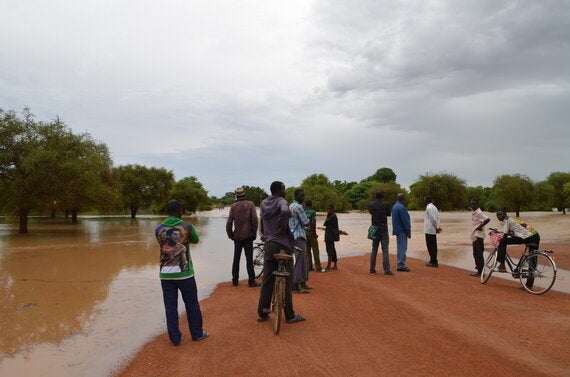Evidence suggests that a small rise in temperature has already resulted in increased transmission of diseases such as malaria and dengue fever in previously cooler highlands. A small rise in temperature can make a significant difference: at 18 degrees Celsius, malaria parasites develop too slowly to mature inside the mosquito. But at a few degrees higher, they can reproduce much more quickly.
Droughts or dry seasons allow mosquitoes to breed in pools of dried rivers and streams. Ethiopian highlands have experienced increasingly extended dry seasons, followed by abnormally heavy rainfall, leading to more mosquitoes. Higher humidity prolongs the lifespan of mosquito eggs, and once there is water, these eggs hatch and the mosquitoes can spread disease.

Understanding the relationship between climate and vector-borne diseases is necessary in order to predict outbreaks of vector-borne diseases based on weather conditions. It also means that interventions such as seasonal malaria chemoprevention, and climate and disease surveillance systems, can be implemented to protect children from malaria when they are most vulnerable - before, during, and immediately after the rainy season.
Rises in temperature, with longer dry seasons, increase the chances of malaria moving into areas where it was previously absent and where immunity may be low. However, while temperatures are generally increasing, malaria rates have been steadily falling. This reduction in cases can be attributed to greater control measures and to changes in social and economic conditions. What is clear is that control and prevention methods for increased vector-borne diseases will need to be tailored according to local and regional needs.
Cambodia has been highlighted as one of the top 10 countries that are most vulnerable to the impacts of climate change, particularly due to its risk of flooding, droughts and a "combination of low levels of income, skill and infrastructure". Steven Iddings, Team Leader for Non-Communicable Diseases and Environmental Health for The World Health Organization (WHO) in Cambodia says that "the unusual weather of 2015 may just be a sample of what's to come. The June to September rainy season never really arrived. Now with aquifers low, drought has a head start."
Current data predicts that Cambodia will experience further temperature increases in the 21st century. Models collated by the University of Oxford indicate that the mean annual average temperature in Cambodia is expected to increase by 0.7 to 2.7°C by the 2060s, and by 1.4 to 4.3°C by the 2090s. Overall average annual rainfall is expected to increase as well, but with more intense wet seasons and drier dry seasons.
The WHO warns that climate change is likely to increase the already high burden of vector-borne diseases such as malaria and dengue fever in Cambodia.
Already in 2015, 2.5 billion people - approximately 40 percent of the world's population - are at risk from dengue, with over 125 countries being infected annually - up from just seven countries before 1970.
Dengue is a climate sensitive disease. Higher temperatures increase the rate of mosquito development and reduce the amount of time needed for the virus to incubate.
Pailin Province in Cambodia has recently experienced a significant rise in dengue cases, with confirmed outbreaks in six villages. There is no known cure or vaccine for dengue, so the best approach to management is prevention through vector control and avoiding mosquito bites.
In anticipation of an increase in vector-borne diseases resulting from climate change, and an increase in population mobility in much of Cambodia, the occurrence and nature of mosquito habitats will change. Predicted increases in flooding may increase the probably of sizeable mosquito population explosions in areas where there were previously low levels.
Malaria Consortium, funded by the German federal enterprise for international cooperation, Deutsche Gesellschaft für Internationale Zusammenarbeit (GIZ), is working to improve healthcare infrastructures and the capacity of health personnel to cope with the increasing threat of vector-borne diseases.
GIZ's Maylin Meincke said, "This project is part of a package of dengue activities that was directly requested by the National Malaria Centre of the Ministry of Health with support of the World Health Organization."
As part of these efforts Malaria Consortium are overseeing a behaviour change communication campaign that supports village malaria workers (VMWs) to promote health seeking behaviour in Pailin, Cambodia. VMWs provide basic health services for their communities as well as share prevention methods and treatment to villagers in vulnerable and remote areas.
Steve Iddings at WHO explained the strategy of focusing on health systems: "To lessen the effects of climate change on dengue and other climate-sensitive diseases, it is essential to strengthen health systems. For example, through education of health professionals, provision of public health infrastructure, enhanced disease surveillance and outbreak response, and improved delivery of primary health care services."
Projects such as Malaria Consortium's should allow countries to better adapt to the health impacts of climate change.
The hope is that projects such as this will raise awareness of the growing health threats triggered by climate change, and will put health on the agenda during the COP21 discussions at the UN Climate Change Conference. Malaria Consortium favours and supports ministries of health and research organisations to develop research that can improve local health capacity for systems that are threatened by climate change in local areas. Such insights can then be used by governments to help coordinate and fund the changes or adaptation required as part vector control programmes.